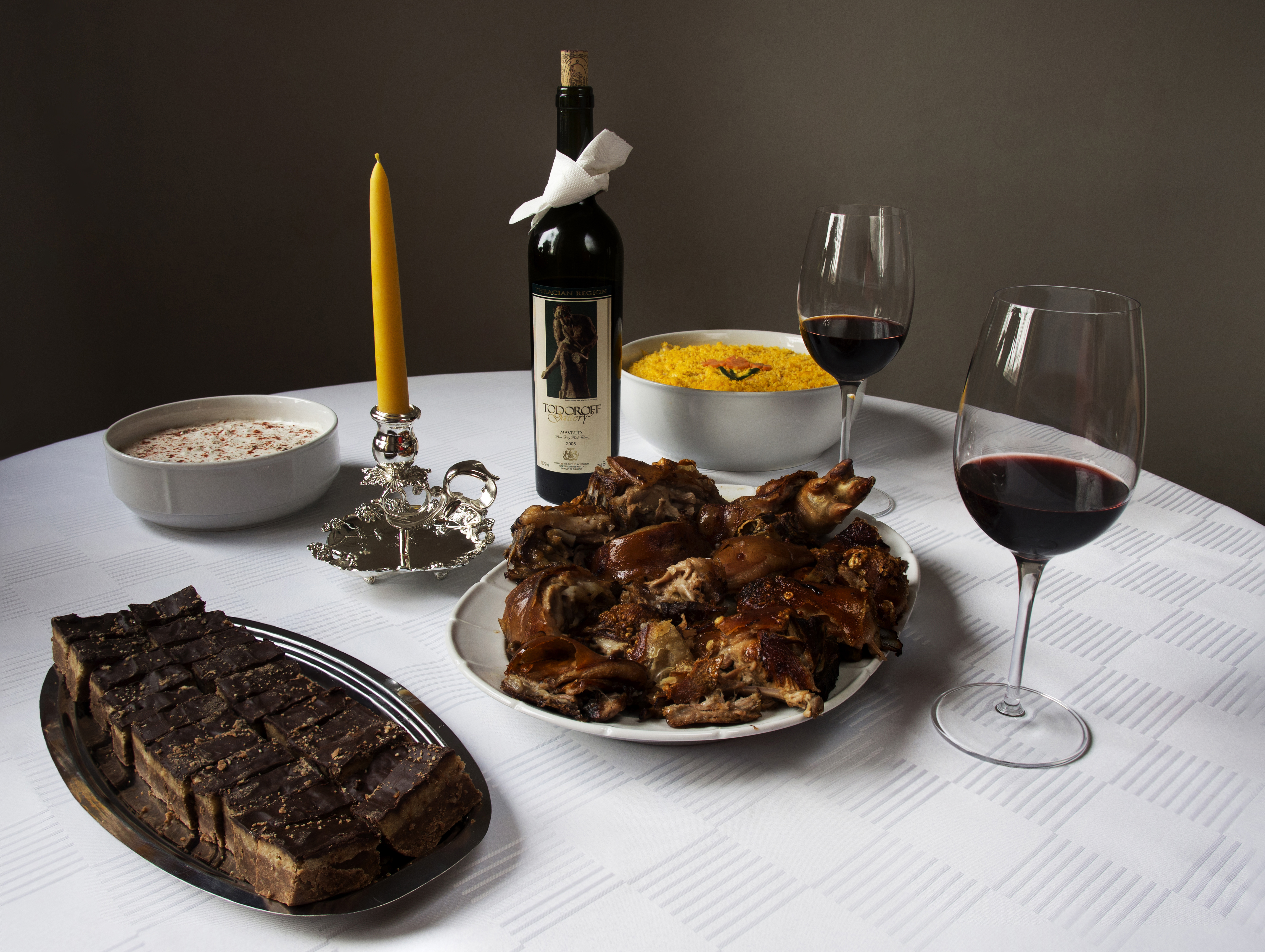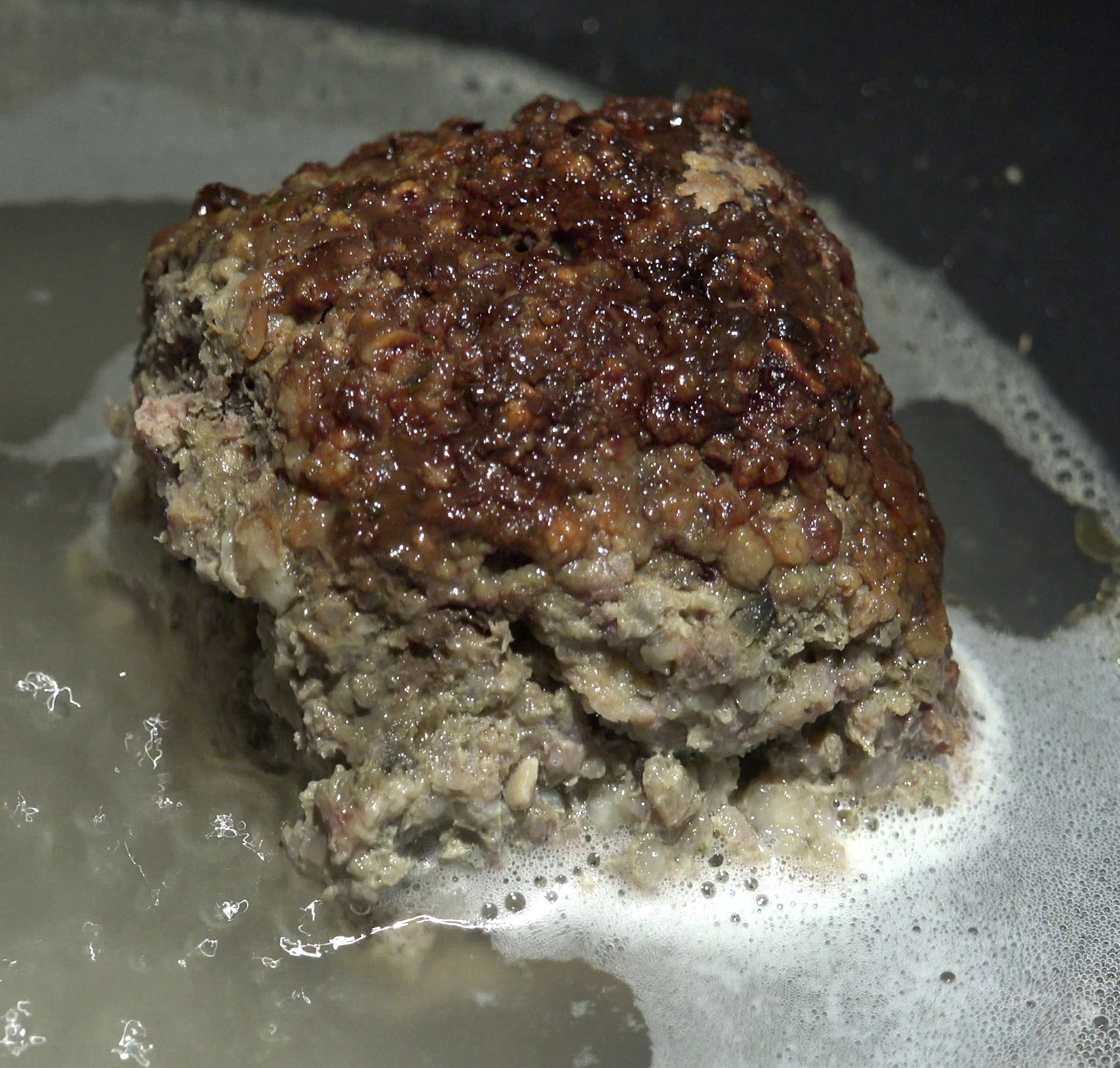|
Caul Fat
Caul fat, also known as lace fat, omentum, or fat netting, is the thin Biological membrane, membrane which surrounds the organ (anatomy), internal organs of some animals, such as cows, sheep, and pigs, also known as the greater omentum in anatomy textbooks. It is used as a casing (sausage), casing for sausages, roulades, pâtés, and various other meat dishes. Examples of such dishes are Vietnamese cuisine, Vietnamese , Swiss cuisine, Swiss , French cuisine, French , Cypriot cuisine, Cypriot , South Africa, South African , British cuisine, British faggot (food), faggots, Serbian cuisine, Serbian and , and Italian cuisine, Italian . In the traditional Ukrainian cuisine, Ukrainian and Russian cuisine, Russian cuisine, caul fat, known as or , was usually filled with and liver (food), liver, and baked in a clay pot in the Russian oven. The Navajo people of the Southwestern United States wrap sheep intestines around strips of caul fat to make a dish called . Gallery File:Salnyk-gre ... [...More Info...] [...Related Items...] OR: [Wikipedia] [Google] [Baidu] |
Sheftalia
Sheftalia (; ; ) is a traditional sausage that originated in Cyprus Cyprus (), officially the Republic of Cyprus, is an island country in the eastern Mediterranean Sea. Situated in West Asia, its cultural identity and geopolitical orientation are overwhelmingly Southeast European. Cyprus is the List of isl .... It is made from caul fat, or omentum, the membrane that surrounds the stomach of pig or lamb, to wrap the ingredients rather than sausage casing. References External links *sheftalia sti kypro Skewered kebabs Cypriot cuisine Greek cuisine Sausages {{Meat-stub ... [...More Info...] [...Related Items...] OR: [Wikipedia] [Google] [Baidu] |
Nature Medicine
''Nature Medicine'' is a monthly peer-reviewed medical journal published by Nature Portfolio covering all aspects of medicine. It was established in 1995. The journal seeks to publish research papers that "demonstrate novel insight into disease processes, with direct evidence of the physiological relevance of the results". As with other ''Nature'' journals, there is no external editorial board, with editorial decisions being made by an in-house team, although peer review by external expert referees forms a part of the review process. The editor-in-chief is João Monteiro. According to the ''Journal Citation Reports'', the journal has a 2021 impact factor of 58.7, ranking it 1st out of 296 journals in the category "Biochemistry & Molecular Biology". The table below provides a detailed overview of recent bibliometric indicators for ''Nature Medicine'': Abstracting and indexing ''Nature Medicine'' is abstracted and indexed in: * Science Citation Index Expanded * Web of Scie ... [...More Info...] [...Related Items...] OR: [Wikipedia] [Google] [Baidu] |
Nature (journal)
''Nature'' is a British weekly scientific journal founded and based in London, England. As a multidisciplinary publication, ''Nature'' features Peer review, peer-reviewed research from a variety of academic disciplines, mainly in science and technology. It has core editorial offices across the United States, continental Europe, and Asia under the international scientific publishing company Springer Nature. ''Nature'' was one of the world's most cited scientific journals by the Science Edition of the 2022 ''Journal Citation Reports'' (with an ascribed impact factor of 50.5), making it one of the world's most-read and most prestigious academic journals. , it claimed an online readership of about three million unique readers per month. Founded in the autumn of 1869, ''Nature'' was first circulated by Norman Lockyer and Alexander MacMillan (publisher), Alexander MacMillan as a public forum for scientific innovations. The mid-20th century facilitated an editorial expansion for the j ... [...More Info...] [...Related Items...] OR: [Wikipedia] [Google] [Baidu] |
Russian Oven
The Russian stove () is a type of Masonry heater, masonry stove that first appeared in the 15th century or earlier. These stoves combine the functions of a traditional stove, oven, and fireplace into a single unit, and serve a broad range of purposes, including cooking (boiling, baking, and smoking), drying plants and mushrooms, providing interior heating and ventilation, bathing, and providing a warm place to sleep (many units include a sleeping berth atop the stove). They can be found in traditional Russian, Ukraine, Ukrainian, Romania, Romanian, and Belarus, Belarusian households. Such stoves burn only firewood. Design A Russian stove is designed to retain heat for long periods of time. This is achieved by channeling the smoke and hot air produced by combustion through a complex labyrinth of passages, warming the bricks from which the stove is constructed. A brick flue () in the attic, sometimes with a chamber for Smoking (cooking), smoking food, is required to slow down the ... [...More Info...] [...Related Items...] OR: [Wikipedia] [Google] [Baidu] |
Liver (food)
The liver of mammals, fowl, and fish is commonly eaten as food by humans (see offal). Pork, lamb, veal, beef, chicken, goose, and cod livers are widely available from butchers and supermarkets while stingray and burbot livers are common in some European countries. Nutrition Animal livers are rich in iron, copper, B vitamins and preformed vitamin A. Daily consumption of liver can be harmful; for instance, vitamin A toxicity has been proven to cause medical issues to babies born of pregnant mothers who consumed too much vitamin A. For the same reason, consuming the livers of some species like polar bears, dogs, or moose is unsafe. A single slice (68 g) of beef liver exceeds the tolerable upper intake level of vitamin A (6410 μg preformed vs. UL for preformed = 3000 μg). 100 g cod liver contains 5 mg of vitamin A and 100 μg of vitamin D. Liver contains large amounts of vitamin B12, and this was one of the factors that led to the discovery of ... [...More Info...] [...Related Items...] OR: [Wikipedia] [Google] [Baidu] |
Kasha
In English, kasha usually refers to the pseudocereal buckwheat or its culinary preparations. In Slavic languages, "kasha" means porridge or puree. In some varieties of Eastern European cuisine, ''kasha'' can apply to any kind of cooked grain. It can be baked but most often is boiled, either in water or milk, but the word can also refer to the grain before preparation, which corresponds to the definition of ' groats'. The word "kasha" is used in Belarus (), the Czech Republic (), Lithuania (), Poland (), Romania and Moldova (), Russia (), Slovakia (), Slovenia (), Kazakhstan, and Ukraine (). The English-language usage of kasha, which refers primarily to buckwheat, probably originated with Jewish immigrants, as did the form ''kashi'' (literally translated as "porridges"). In Ashkenazi Jewish culture As an Ashkenazi-Jewish comfort food, kasha is often served with onions and brown gravy on top of farfalle, known as kasha varnishkes. Kasha is a popular filling for knishes and ... [...More Info...] [...Related Items...] OR: [Wikipedia] [Google] [Baidu] |
Russian Cuisine
Russian cuisine is a collection of the different dishes and cooking traditions of the Russians, Russian people as well as a list of culinary products popular in Russia, with most names being known since pre-Soviet times, coming from all kinds of social circles. History The history of Russian cuisine was divided in four groups: Old Russian cuisine (9th to 16th century), Old Moscow cuisine (17th century), the cuisine that existed during the ruling of Peter the Great, Peter and Catherine the Great (18th century), and finally Petersburg cuisine, which took place from the end of the 18th century to the 1860s. In the Old Russian period, the main food groups were bread, grains, and other foods that contained starch. Women baked pies with many different fillings, such as mushrooms or berries. During gatherings, a loaf of bread and salt was always present. Kasha, such as buckwheat and oats, were represented as wellbeing to the household. Many Russians used honey and berries and mad ... [...More Info...] [...Related Items...] OR: [Wikipedia] [Google] [Baidu] |
Ukrainian Cuisine
Ukrainian cuisine is the collection of the various cooking traditions of Ukrainians, the people of Ukraine, one of the largest and most populous European countries. It is heavily influenced by the rich dark soil () from which its ingredients come, and often involves many components. Traditional Ukrainian dishes often experience a complex heating process – "at first they are fried or boiled, and then stewed or baked. This is the most distinctive feature of Ukrainian cuisine". The national dish of Ukraine is red borscht, a well-known beet soup, of which many varieties exist. However, (boiled dumplings similar to Pierogi#Ukraine, pierogi) and a type of cabbage roll known as are also national favourites, and are a common meal in traditional Ukrainian restaurants. These dishes indicate the regional similarities within Eastern European cuisine. The cuisine emphasizes the importance of wheat in particular, and grain in general, as the country is often referred to as the "breadbaske ... [...More Info...] [...Related Items...] OR: [Wikipedia] [Google] [Baidu] |
Italian Cuisine
Italian cuisine is a Mediterranean cuisine#CITEREFDavid1988, David 1988, Introduction, pp. 101–103 consisting of the ingredients, recipes, and cooking techniques developed in Italy since Ancient Roman cuisine, Roman times, and later spread around the world together with waves of Italian diaspora. Significant changes Columbian exchange, occurred with the colonization of the Americas and the consequent introduction of potatoes, tomatoes, capsicums, and maize, as well as sugar beet—the latter introduced in quantity in the 18th century. It is one of the best-known and most widely appreciated Gastronomy, gastronomies worldwide. Italian cuisine includes deeply rooted traditions common throughout the country, as well as all the diverse Regional cuisine, regional gastronomies, different from each other, especially between Northern Italy, the north, Central Italy, the centre, and Southern Italy, the south of Italy, which are in continuous exchange. Many dishes that were once region ... [...More Info...] [...Related Items...] OR: [Wikipedia] [Google] [Baidu] |
Serbian Cuisine
Serbian cuisine () is a Balkan cuisine that consists of the culinary methods and traditions of Serbia. Its roots lie in Serbian history, including centuries of cultural contact and influence with the Greeks and the Byzantine Empire, the Ottomans, and Serbia's Balkan neighbours, especially during the existence of Yugoslavia. Historically, Serbian food develops from pastoral customs that involved the keeping of sheep in mountain highlands, in a climate and regional context that favoured animal husbandry over vegetable farming; Serbian food is therefore traditionally richer in animal products and basic grains—corn, wheat and oats—than fresh vegetable dishes. Following the abandonment of widely practiced pastoral lifestyles, Serbian food emerged through the Middle Ages heavily dependent not on lamb or mutton, but on the keeping of pigs for the annual cull and the production of various cured meats, such as sausages, bacon and ham products. The Serbian government has passed laws ... [...More Info...] [...Related Items...] OR: [Wikipedia] [Google] [Baidu] |
Faggot (food)
Faggots are meatballs made from minced off-cuts and offal (especially pork, and traditionally pig's heart, liver and fatty belly meat or bacon) mixed with herbs and sometimes bread crumbs. It is a traditional dish in the United Kingdom, especially South and Mid Wales and the English Midlands. Faggots originated as a traditional cheap food consumed by country people in Western England, particularly west Wiltshire and the West Midlands. Their popularity spread from there, especially to South Wales in the mid-nineteenth century, when many agricultural workers left the land to work in the rapidly expanding industry and mines of that area. Faggots are also known as "ducks" in Yorkshire, Lincolnshire and Lancashire, often as "savoury ducks". The first use of the term in print was in the ''Manchester Courier and Lancashire General Advertiser'' of Saturday 3 June 1843, a news report of a gluttonous man who ate twelve of them. Preparation and serving Commonly, a faggot consists ... [...More Info...] [...Related Items...] OR: [Wikipedia] [Google] [Baidu] |








